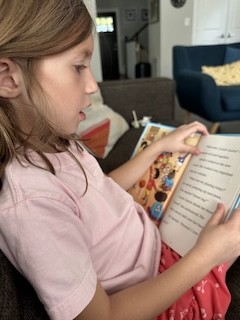Teacher question: I’ve heard that having students read digital texts is a bad idea, but our school has purchased tablets for everybody and wants us to use these for much of our instruction. What say you? Good idea or bad idea?
RELATED: Knowledge or Comprehension Strategies -- What Should We Teach?
Shanahan responds:
Generally, research has found that digital books are read with lower comprehension and more mind wandering (Clinton, 2019; Vargas, Ackerman, & Samerón, 2018). Admittedly, most evidence on this comes from studies of college students. However, even when the studies have focused on elementary age students, the results are the same. Kids don’t read as well digitally as they do more traditional text.
Even more discouraging than studies showing lower comprehension with digital text, there is a small amount of data suggesting that the more time kids spend reading digitally in school, the lower their reading comprehension tends to be (Samerón, Vargas, Delgado, & Baron, 2023).
Why is this?
Adults and older students seem to have difficulty adjusting to demands when reading screens as opposed to book pages. For example, in one recent study (Delgado & Salmerón, 2021), students were asked to read either in a time pressured situation or in one with no time demands. They found that with traditional paper books, the students reduced their mind wandering under timed conditions. That didn’t happen when reading screens. Their mind wandering continued much as it had done when there was no time pressure, and comprehension fell accordingly.
Media often characterize kids as “digital natives,” distinct from we antediluvian grown-ups, as if being young conferred a predisposition to all things computer. Think of all those television shows and movies where the kids fix mom or dad’s phone in a nanosecond!
This research says adults don’t read screens as well as they do old-fashioned paper. And, neither do kids.
But to be fair, that isn’t really what you asked me.
Your question wasn’t whether kids do a good job reading digital text. No, you asked about whether digital text was useful for teaching students to read – quite a different matter in my opinion.
Personally, I used to do little digital text reading – rarely for work, never for pleasure. I still prefer hard copy, but I read a lot on my tablet. For some kinds of reading, I even prefer electronic text.
At one time, when someone would send me a PDF, I’d print it before taking it on. But someplace along the way, I stopped that intermediary step reading the electronic file instead of the paper.
And, for those who believe that reading instruction should be more about joy than the quotidian, it is worth noting the steady increase in the purchase of digital fiction. Whether some readers prefer electronic ink or are just giving in to the conveniences of this kind of text, clearly pleasure reading doesn’t preclude digital.
I bet many people have gone through – or are going through – some version of this transformation. That means kids will need to learn to read electronic text more successfully than they do now. If they don’t, they won’t succeed in academia or the workplace – futures for which we are supposedly preparing them.
There have been many studies comparing digital and traditional reading, and that enterprise continues unabated. But there have been few studies exploring the advantages of digital reading – and even fewer (none?) aimed at identifying strategies readers could use to adjust their digital reading in ways that will allow it to be successful.
Introspection tells me that I tend to skim more with digital than paper text. I don’t know why, but I sense a kind of hurrying. Perhaps the electronic displays are harsh and less pleasant, so I try to move it along or surrender to mind wandering. That has been improving for me, but I’m not sure why? It could just be experience – I’m more used to the format – or it could be the adjustments that I’ve made to font size.
Wouldn’t it be cool if the device itself monitored your speed and called it to attention in a 2001: Space Odyssey voice: “Dave, you read that screen faster than the last several. Did you mean to start skimming?”
Some research suggests that digital readers give in to distraction more, sliding into Google instead of maintaining their reading. Many of the digital mechanisms for children’s reading supplement the texts with games and puzzles and the like. Research shows that those mechanisms are more of a distraction, undermining reading comprehension rather than fortifying it (Furenes, Kucirkov, & Bus, 2021).
That tells me that electronic readers need to try to resist distraction, since giving into it has unfortunate consequences.
I suspect that my memory for what I read electronically may be a bit deficient, too. It seems to deteriorate more quickly. Highlighting text as I read and then reviewing those parts before I “close the book” helps. Kids are usually discouraged from highlighting school textbooks, but they can markup electronic copy to their hearts’ content and instruction can provide a helpful guide to that kind of annotation.
Unfortunately, many electronic books are not particularly flexible or supportive of highlighting, marginal notes, or annotation. Electronic publishers interested in the children’s market should be thinking how to facilitate better such reader-text interaction. Likewise, as helpful as the dictionary assistance is (it has been found to improve children’s vocabulary), it isn’t doing much to either improve comprehension or to help young readers to independence – such as guiding them to use context to determine word meanings or providing more precise and helpful definitions.
There is another kind of memory loss I have noticed. When reading traditional text my brain works a bit like a GPS device. It tells me that certain information was presented on the verso or recto page (left or right), near the top or near the bottom, and that sometimes allows me to go back and find something later. I can’t do that on my tablet. My memories don’t seem to have that kind of physical orientation. To regain that I find I need to find a more specific verbal link – memorizing an uncommon word or phrase, so that I can depend upon the marvelous search capacity of the computerized “books.”
I’m happy to encourage electronic publishers to improve their products, and researchers to explore how readers can effectively overcome the limitations of electronic reading. But those are seeds planted for the future – perhaps a far-off future.
What can teachers do now that will help?
1. Reading instruction should focus on both electronic and paper texts.
2. Teachers should be frank with students. They should let kids in on the fact that their comprehension is likely to be lower with a tablet or phone. Talking about the problem openly may help them to resist distraction and intensify effort.
3. I’ve suggested here some adjustments that I have made to try to be more effective in digital reading, but don’t know whether these are helpful to others. I’d suggest encouraging kids to experiment with some of these kinds of ideas – and I’d also encourage some brainstorming on their part to see what works for them.
4. Obviously, there is no research on much of what I have suggested here – very different from a usual Shanahan on Literacy blog. However, there is plenty of research that shows developing agency among learners can be motivational and can empower greater success with other tasks (e.g., Bandura, 2001; Winne, 2018). Maybe it isn’t too big a leap to see the consistency of these suggestions with that body of research.
I guess I’m saying that your school has done a good thing (I think), but it will only be a good idea if you and your colleagues figure out how best to make it work for learning. Otherwise, they’ve likely set your kids back a bit.
READ MORE: Shanahan On Literacy Blog
References
Bandura, A. (2001). Social cognitive theory: An agentic perspective. Annual Review of Psychology, 52, 1-26.
Clinton, V. (2019). Reading from paper compared to screens: A systematic review and meta-analysis. Journal of Research in Reading, 42, 288-325. doi.org/10.1111/146-9817.12269
Delgado, P., & Salmerón, L. (2021). The inattentive on-screen reading: Reading medium affects attention and reading comprehension under time pressure. Learning and Instruction, 71, 13. doi.org/10.1016/j.learninstruc.2020.101396
Delgado, P., Vargas, C., Ackerman, R., & Salmerón, L. (2018). Don’t throw away your printed books: A meta-analysis on the effects of reading media on reading comprehension. Educational Research Review, 25, 23-28. doi.org/10.1016/j.edurev.2018.09.003
Furenes, M. I., Kucirkova, N., & Bus, A. G. (2021). A comparison of children’s reading on paper versus screen: A meta-analysis. Review of Educational Research, 91(4), 483-517. doi.org/10.3102/0034654321998074
Salmerón, L., Vargas, C., Delgado, P., & Baron, N. (2023). Relation between digital tool practices in the language arts classroom and reading comprehension scores. Reading and Writing, 36, 175-194. doi.org/10.1007/s11145-022-10295-1
Winne, P. (2018). Cognition and metacognition within self-regulated learning. In D. Schunk & J. Greene (Eds.), Handbook of self-regulation of learning and performance (2nd ed., pp. 36-48). New York: Routledge.







Comments
See what others have to say about this topic.